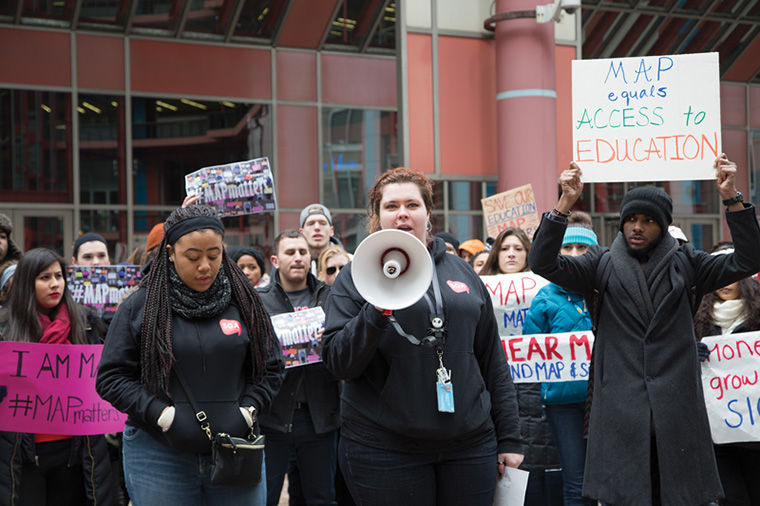Higher-ups should reconsider decision not to fund MAP grants
Students protested Illinois’ unfulfilled promise of distributing Monetary Award Program grants outside the Thompson Center Feb. 16.
April 4, 2016
Columbia has now joined many other colleges statewide in facing increased struggles—or a complete inability—to provide students with the state-funded grant aid they rely on to attend college, such as the Monetary Award Program grant that has been made unavailable to thousands of students because of the Illinois state budget impasse.
As reported in the Front Page story, Columbia students enrolled for the upcoming 2016–2017 academic year will not be able to benefit from MAP grant aid, leaving many students to question how they will shoulder the added expense.
While the college deserves some credit for managing to cover students’ MAP grant aid for the 2015–2016 academic year when other Illinois universities have failed to do the same, it’s valid to ask why the school cannot reconsider its decision not to advance these desperately needed funds for the 2016–2017 academic year.
Columbia’s failure to make up for the loss of state-funded aid means that it will be tougher for low-income students to attend the college and that some students will not be capable of returning in the fall.
Columbia’s mission statement acknowledges that a student body that is diverse racially, culturally and economically is crucial to the college’s goals of educating students effectively before they enter the professional workforce.
It also states: “Columbia conducts education in close relationship to a vital urban reality and serves an important civic purpose by active engagement in the life and culture of the city of Chicago.”
The college’s financial woes are no secret, but the school should reconsider ways to reallocate funds so that MAP grant recipients are still able to attend Columbia.
The upcoming student center, for example, is still in the very early planning stages.
Students, staff, faculty and administrators have long sought the addition of a centralized student space on campus, but we have all already waited for such an addition for years.
Just as other schools have reallocated building funds or dipped into their endowments, the administration should consider putting a one-year hold on the student center’s development and shifting funds to students whose aid has been withdrawn.
We all would like to see the student center completed as soon as possible, but it may not be worth the loss of potentially as many as 2,000 students and the attendant loss of diversity.
In addition to putting the student center on hold, the college may also want to consider taking action on the high-priced Johnson Publishing Building, located at 820 S. Michigan Ave., which was purchased as a potential library and school center.
The new administration rejected those plans but the property has sat vacant for nearly a decade.
Is it really worth holding on to a large, empty building instead of retaining students who have already given so much of their time and money to this college?
While it’s understandably a tense issue that the college’s higher-ups would rather ignore, it’s crucial that President and CEO Kwang-Wu Kim find a way to aid those students who worked so hard to attend Columbia.
Not only would serving students’ immediate needs be the right thing to do, but it’s a far stronger accomplishment than raising funds for a building.








